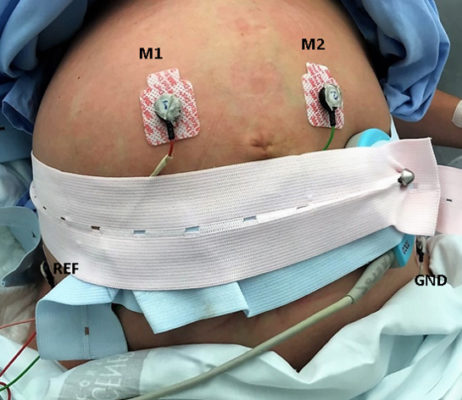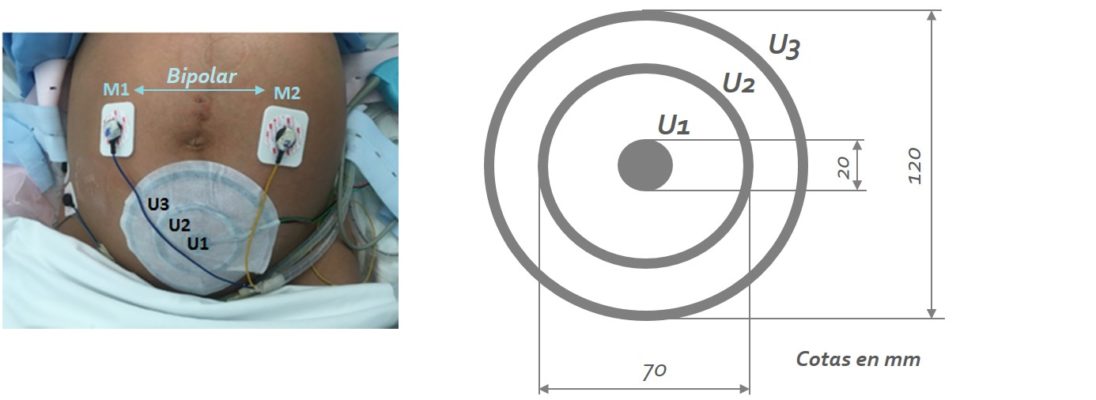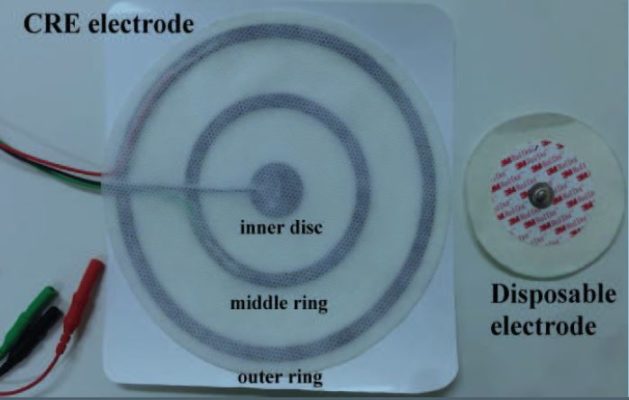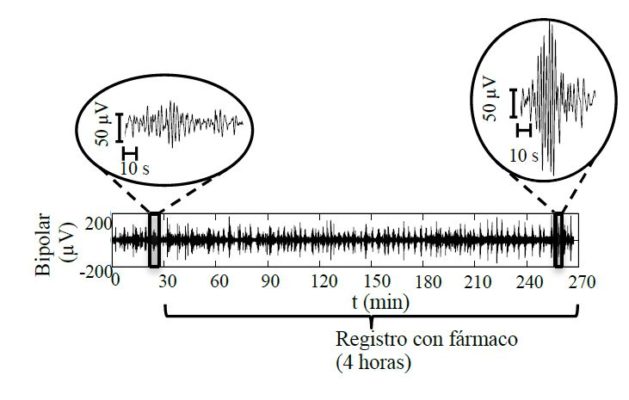Electrohysterology, building bridges for clinical use in obstetrics (DPI2015-68397-R)
Ambulatory monitoring of the uterine electromyogram for the prediction of preterm / full-term delivery and the type of termination (GV / 2014/029)
Development and application of new sensing techniques for the non-invasive monitoring of myoelectric activity during pregnancy (PPUPV-20100996)
Childbirth is the process with which the pregnancy ends. When and how this process has associated important maternal-fetal risk situations that require the attention of the medical and technical community. P.e. Preterm birth is the leading worldwide cause of neonatal mortality reaching 11.1% of all births and is currently an unresolved problem. Also, the ratios of labor induction have increased considerably in recent decades however there is great uncertainty in predicting its success or whether a cesarean section will be required. Knowing the electrophysiological state of the uterus and its degree of ‘maturity-excitability and propagability of the uterine muscle cells- is key to estimating the onset of labor and the response to the drugs used in induction. In this sense, manometric techniques for routine clinical use (tocography on the abdominal surface, intrauterine pressure) are limited to monitoring uterine contractions from the resultant mechanics of contractile bioelectric activity. In addition, tocography provides unreliable information and depends on the subjectivity of the examiner. Recently, the analysis of uterine myoelectric activity captured on the surface (electrohysterogram, EHG) has proved to be one of the most promising biophysical markers not only of uterine dynamics but also of the electrophysiological state of the uterus. However, despite showing that the EHG provides very valuable information, there has been no translation of this technique to clinical use.
Moving the EHG to clinical practice requires addressing the main demands of obstetricians: simplifying protocols and signal acquisition systems, verifying their usefulness in clinical scenarios and facilitating the interpretation of acquired information. In the present project, these demands are addressed in order to help physicians in making decisions regarding the management and planning of the final stage of pregnancy and childbirth. Specifically, it is intended:
-Simplify the protocols and equipment necessary for the non-invasive registration of the EHG
-Get from the EHG a signal morphologically similar to the usual pressure records and also allow to estimate the intensity of contractions (not provided by tocography)
-To help predict the start of preterm birth to facilitate the selection and effectiveness of therapy and reduce unnecessary hospital admissions
-Characterize the uterine electrophysiological response to the drugs used in the induction of labor and predict early if the induction will be successful or cesarean section will be required, avoiding the prolongation of the induction process, reducing maternal-fetal risks and favoring a better use of the clinical resources.
To this end, a ‘simplified’ system for the EHG registration in clinical use will be developed together with signal analysis tools and decision support systems that combine the usual obstetric parameters and the uterine electrophysiological information derived from the EHG, generating interpretation systems automatic and direct status of the patient and prediction of possible future situations. This project would have a significant impact on: the maternal-fetal health, the optimal allocation of health resources and their associated economic costs, and on the technological transfer of a product with a great market potential.
• A simple, comfortable and robust EHG record system has been developed for use in the clinical setting.
• Records have been obtained in conditions of active and antepartum labor in the University and Polytechnic Hospital (HUP) La Fe with which the superiority of the EHG has been demonstrated over TOCO in the detection of uterine contractions.
• Algorithms for the detection and elimination of motion artifacts present in the EHG registers have been developed for an automatic, robust and convenient identification of the EHG-burst (crucial for the future integration of myoelectric techniques in the clinical environment)
• Different parameters of the EHG signals have been obtained (temporal, spectral and ..) and prediction models of the type of onset of birth (spontaneous / induction) have been developed based on the parameters obtained
• Active ring electrodes have been developed for the uptake of EHG, demonstrating the ability of these electrodes to capture the uterine myoelectric activity, also presenting better spatial resolution than conventional electrodes.
• Likewise, a preliminary database has been generated that contains information on the obstetric variables of interest, records of EHG obtained with the own system developed by the group and conventional pressure registers (TOCO and IUP) in women who are has induced labor and analyzed the electrophysiological response of the uterus to induction drugs by obtaining characteristic parameters derived from the EHG signal. Preliminary results indicate that in women who reach active labor after induction, the EHG-Bursts experience an increase in amplitude and an increase in the high frequency content that can be appreciated after about 2 hours after the administration of the drug.
• The first phase of morphological approximation of intrauterine pressure has been covered from GHG records using mono- and multiparameter estimations, using the value of the rectified signal as the estimation parameters of the IUP, the first non-normalized moment derived from the spectrogram and the operator Teager.
• Regarding the development of systems to help diagnose premature birth, more than 100 records have been made at the Hospital Politècnic i Universitari La Fe of Valencia in women with the threat of premature birth and temporal, spectral and complexity estimators have been obtained and regularity of the EHG signals, both of the EHG-burst associated with the contractions, and in complete signal sections.
• Regarding the characterization of the electrophysiological effect of delivery induction drugs and develop systems to help predict the success of induction. We have obtained temporal, spectral parameters and estimators of complexity and regularity of the EHG signals, both of the EHG-burst associated with the contractions, as well as of complete sections of signal and a set of parameters that could be used in the systems has been defined. of prediction of the success of the induction if in this one the drug Misoprostol is used.
• Regarding the transfer of the results of the research, it has crystallized with contacts and contracts with companies of Biomedical products such as OT-Bioelecttronica, Spes-Medica or General Electric, (EPOs) interested in the results of this project. At the academic level a doctoral thesis has been defended in this area within the research group and (Dr. D. José Alberola Rubio) and three are in the process of completion (PhD students Carlos Benalcázar Parra, D. Javier Mas Cabo, D Ángel López Corral)
ESAII, Universitat Politècnica de Catalunya, Institut de Bioengineering de Catalunya (IBEC) and CIBER of Bioengineering, Biomaterials and Nanomedicine (CIBERBBN). The collaboration has been carried out in the field of non-invasive recording of myoelectric diaphragmatic activity, deriving publications in international congress. Collaboration has involved, on the one hand, the translation of the use of Laplacian techniques to the field of diaphragmatic electromyography and, on the other hand, the incorporation of certain parameters used for the characterization of diaphragmatic myoelectric activity to the characterization of uterine myoelectric activity, such as case of the binary Lempel-Ziv parameter.
Collaboration with the team led by Dr. Dña María Salud Guillem of the Bioengineering Researching Group (BioITACA) of the UPV. The background of the UPV research group of this project has been provided in non-invasive bioelectrical records, and particularly Laplacians, to theoretical studies on its use for a better surface characterization of cardiac activity, specifically of atrial activity. The preliminary results obtained by simulations point to a higher spatial resolution of the Laplacian records obtained with annular electrodes compared to those obtained with conventional electrodes (monopolar or bipolar disc) of the same size. The results obtained indicate that surface records made with concentric annular electrodes could be used in electrohysterography to improve the estimation of the speed of propagation of uterine activity, opening a new line of research in this field for the group of researchers of the present project. The BioITACA group provides the development of models that allow analyzing and comparing the response of the ring electrodes with respect to conventional electrodes.
Collaboration with the group led by Dr. Eduardo García Breijó of the Interuniversity Research Institute of Molecular Recognition and Technological Development of the UPV for the development of new electrodes on flexible and textile substrates for non-invasive uptake of biollectric signals. Several prototypes have been developed on textile substrates that are going to be tested on the recording of the electrocardiographic signal. After this first phase, it is expected to obtain a final prototype that can be used for the recording of other surface myoelectric signals, with special emphasis on the development of a comfortable, ergonomic and «reliable» electrode for the monitoring of uterine myoelectric activity in pregnant women. The Interuniversity Research Institute for Molecular Recognition and Technological Development of the UPV provides the «know-how» and the necessary technology for the manufacture of electrodes (machines, access to distributors and materials to be screen-printed, gravure, electrodeposited or tinted).
Collaboration with Dr. D. Victor Manuel Santiago Praderas of the UPV to apply some of the computation and characterization tools developed in the present project to the processing of brain signals (electroencephalography), fundamentally those estimators of complexity, order and synchronization of signals.





